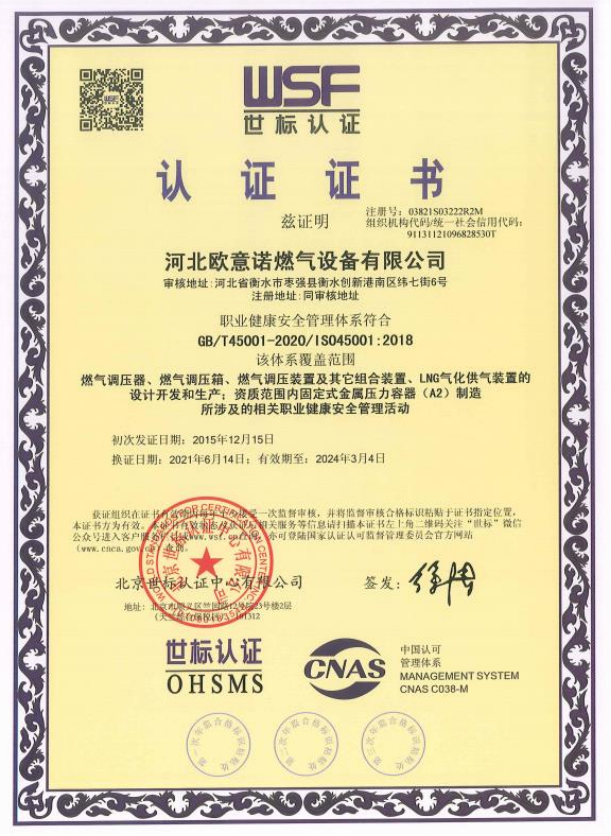
Dec . 24, 2024 22:56
Back to list
Natural Gas Pressure Regulation Device for Safe and Efficient Flow Control
Understanding Natural Gas Pressure Reducers Essential Components for Safety and Efficiency
Natural gas is one of the most widely utilized energy sources across the globe, powering homes, industries, and vehicles. However, the delivery and use of natural gas require precise control to ensure safety and efficiency. One of the essential components in the natural gas supply chain is the pressure reducer, also often referred to as a pressure regulator. This device plays a crucial role in maintaining a consistent pressure level for the safe and efficient operation of natural gas appliances and systems.
What is a Natural Gas Pressure Reducer?
A natural gas pressure reducer is a mechanical device designed to control the pressure of natural gas as it travels from the supply source—such as a pipeline—into homes or industrial facilities. The primary function of this device is to reduce the high pressure of natural gas down to a safe, manageable level that can be utilized by end-use applications like heaters, stoves, and generators.
How Does it Work?
The operation of a pressure reducer is based on the principles of physics, particularly fluid dynamics. Gas from the supply line enters the pressure reducer at high pressure. The device contains a diaphragm or a spring-loaded mechanism that responds to changes in pressure. As the gas enters, the diaphragm flexes to adjust the flow based on the downstream pressure that is being sensed. When the pressure drops too low, the diaphragm pushes against the spring, allowing more gas to flow through. Conversely, if the pressure exceeds the set point, the diaphragm will limit the flow, thereby maintaining a stable output pressure.
Types of Pressure Reducers
natural gas pressure reducer

There are various types of natural gas pressure reducers, each designed for specific applications and pressure requirements. Some of the most common types include
1. Single-Stage Regulators These are typically used in residential applications where the pressure does not vary significantly. They provide a straightforward method for achieving desired pressure levels. 2. Two-Stage Regulators Often used in commercial and industrial settings, these regulators help maintain a more consistent pressure despite fluctuations in the supply line. They operate in two stages, initially reducing the pressure at the first stage before passing it to a second regulator for fine-tuning. 3. Electronic Regulators Modern advancements have led to electronic pressure control systems that offer enhanced accuracy and responsiveness. These systems often integrate with smart home technology, providing real-time monitoring and adjustments.
Importance of Pressure Regulation
Effective pressure regulation is vital for several reasons
1. Safety High pressure can lead to dangerous situations, including leaks or explosions. Proper regulation ensures that pressure remains within safe limits, protecting lives and property. 2. Efficiency Appliances designed to operate at specific pressure levels perform more efficiently when provided with the appropriate gas pressure. This reduces waste of energy and extends the lifespan of the equipment. 3. Environmental Impact Correct pressure regulation can minimize emissions from natural gas appliances, contributing to cleaner air and reduced carbon footprints.
Conclusion
Natural gas pressure reducers are indispensable in the safe and efficient use of natural gas. Whether in residential or industrial settings, these devices ensure a consistent and safe supply of gas to appliances, ultimately enhancing operational efficiency and safety. As technology continues to advance, the future of natural gas pressure regulation looks promising, with innovations aimed at improving functionality and integration with smart systems. Understanding and maintaining these vital components is essential for anyone involved in the natural gas supply industry, and for consumers who wish to maximize the benefits of their natural gas appliances.
Next:
Latest news
-
Safety Valve Spring-Loaded Design Overpressure ProtectionNewsJul.25,2025
-
Precision Voltage Regulator AC5 Accuracy Grade PerformanceNewsJul.25,2025
-
Natural Gas Pressure Regulating Skid Industrial Pipeline ApplicationsNewsJul.25,2025
-
Natural Gas Filter Stainless Steel Mesh Element DesignNewsJul.25,2025
-
Gas Pressure Regulator Valve Direct-Acting Spring-Loaded DesignNewsJul.25,2025
-
Decompression Equipment Multi-Stage Heat Exchange System DesignNewsJul.25,2025

